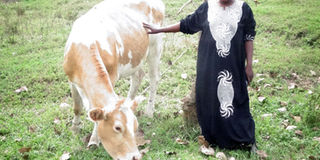Nabukeera earning from 3-acre land

Rehema Nabukeera milks 30 litres of milk from her cows everyday. PHOTO by alex ashaba.
What you need to know:
- Rehema Nabukeera harvests the fish after seven months and sells each tilapia at Shs10,000. She also has a banana plantation and dairy cows. On average, the farmer gets 30 litres of milk per day, writes Alex Ashaba & Felix Basiime.
Rehema Nabukeera’s three-acre farm in Kanyambeho Village, Kiko Town Council in Kabarole District, is the envy of the community because of the various agribusiness ventures she engages in.
Eight years ago after dropping out of school in Senior Four, Nabukeera decided to try her luck in smallscale mixed farming.
The 32-year old farmer grows bananas, vegetables, rears cows and keeps fish.
Nabukeera was busy inspecting her banana plantation and fish pond when Seeds of Gold arrived for the interview.
At 10am, the cows were already feeding while some had already fed and were resting under trees in the farm.
She says she decided to concentrate on fish keeping, dairy production and banana farming after realising that she was putting a lot time and resources on vegetables but at the end of the day she earned less.
Banana
“I have to deliver the banana at the market. Demand is high because of the rainy season,” she explains.
The type of bananas, Nabukeera grows include nakyetengu, nakabululu, kisansa, ntika, sukaali ndiizi (apple banana) and plantains among others.
“With the little money from relatives and friends, I started farming sometime in 2010 after dropping out of school,” Nabukeera recounts, saying she started with two enterprises – banana farming and fish keeping.
Onions, tomatoes and egg plants are some of the vegetables she moved to later as she expanded her agribusiness. She grows the vegetables at the backyard of her kitchen.
“There was good market for the vegetables in Kiko Town and still is. I would deliver my produce to specific families earning Shs150,000 in a good week,” explains Nabukeera.
She sells the bananas from Shs10,000 to Shs12,000 each depending on the variety and size to schools, individuals and markets in Kiko and Fort Portal.
Fishing
Next to a village stream, Nabukeera has 300 square-metre fish pond that normally hosts 1,000 tilapia and catfish at any time.
She started the fish business after a series of training by the Ministry of Agriculture, Animal Industries and Fisheries.
The farmer feeds the fish on pellets that she buys at Shs54,000 per 50 kilogramme bag in Fort Portal. She supplements the feeds with earth worms and fertilises the pond with dried chicken droppings and cow dung.
The farmer harvests the fish after seven months and sells each tilapia at Shs10,000 while catfish goes between Shs18,000 to Shs22,000.
Cows
Nabukeera is also in dairy production having bought three fresian cows at Shs1.5m each three years ago. On average she obtains about 30 litres of milk per day (20 in the morning and 10 in the evening). She sells each litre at Shs1,200.
“There is a ready market for my milk locally, but my main outlet is the hotel in our major town. I also sell to the needy population and because of the quality of my milk it sells like hotcake,” he says.
To feed her cows, Nabukeera had to set aside half an acre to grow fodder such as napier grass.
Her cattle are kept in a zero-grazing unit which is more economical and allows for easy disease and pests control. Sometimes she tethers the cows in the neighbourhood.
Nabukeera told Seeds of Gold that for one to succeed in dairy farming, you need to ensure there is enough water and feeds for the cattle.
Future plans
Nabukeera plans to construct another five fish ponds at her home and introduce different fish species and buy more cows to increase her income.
“If I get more money say a grant from government, I will make sure that I have more ponds and also start dairy production and get more training to venture in different businesses that will increase my earning,” she says.
Advice
Nabukeera says while mixed farming is beneficial, a farmer risks burning out as he or she spreads their resources such as time, money and labour to the limit.
“One should plan carefully lest this kind of farming turns out to be a burden as the farmer may be unable to maximise productivity. There is also a challenge with diseases, which may spread from one crop to another, but overally, this kind of farming is better than mono farming.”




